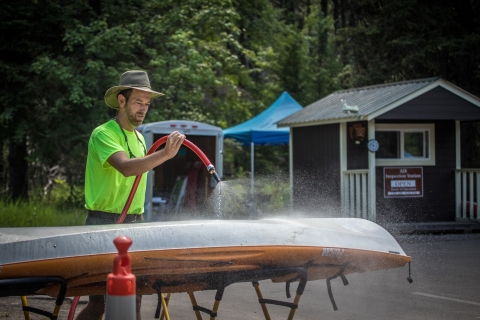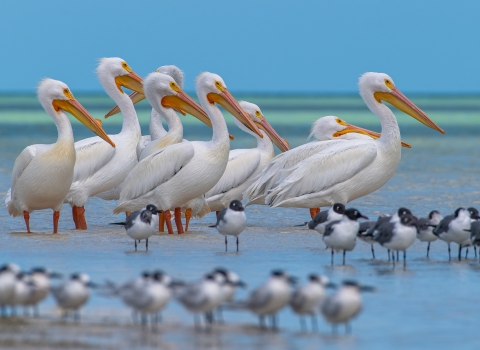Aquatic invasive species invasive species
An invasive species is any plant or animal that has spread or been introduced into a new area where they are, or could, cause harm to the environment, economy, or human, animal, or plant health. Their unwelcome presence can destroy ecosystems and cost millions of dollars.
Learn more about invasive species cause tremendous harm to our environment, our economy, and our health. They can drive out and eat native plants and wildlife, spread diseases, and damage infrastructure. Driven by human activity and climate change climate change
Climate change includes both global warming driven by human-induced emissions of greenhouse gases and the resulting large-scale shifts in weather patterns. Though there have been previous periods of climatic change, since the mid-20th century humans have had an unprecedented impact on Earth's climate system and caused change on a global scale.
Learn more about climate change , invasive species threaten nearly half of the imperiled species in the United States and have contributed to more than 40 percent of the current listings under the Endangered Species Act.
Luckily, with a few simple steps you can protect our aquatic resources and ensure that these harmful species do not spread into new areas. The most important things you can do to prevent the introduction and spread of invasive species are to clean your watercraft and outdoor recreation gear after each use and never release unwanted pets or aquarium contents into the wild.
We all have a role to play in protecting our aquatic wildlife and habitats. Here are five steps you can take to protect our waterways.
1. Stop Aquatic Hitchhikers!
Recreational activities such as recreational boating, angling, waterfowl hunting, and diving may spread aquatic invasive species. Some aquatic invasive species can attach to boats, while others can become tangled on propellers, anchor lines, or boat trailers. Many species can survive in bilge water, ballast tanks, and motors or may hide in dirt or sand that clings to nets, buckets, anchors, and waders. Some common ways that species may be moved during recreational boating and other activities include:
Attaching to watercraft, trailers, motors, and fishing gear.
Transport by ballast water, bilge, livewells, and other water containing devices.
Dumping of unwanted live bait.
Tangled in fishing lines and downrigger cables
Sticking to the soles of waders
Clinging to the pontoons of seaplanes
Trapped in mud on a dog’s paws
Just one organism, or in some cases a piece of a plant, is enough to start a new invasion. Fortunately – ALL invasions are preventable! Completing a few simple steps can stop aquatic hitchhikers in their tracks!
2. Clean, Drain, Dry and Dispose… In every waterbody, every time.
CLEAN off visible aquatic plants, animals, and mud from all equipment before leaving water access. Cleaning will remove visible large-bodied organisms attached to or in watercraft or recreational equipment. Rinsing with water removes organisms, while hot water often kills them. Water at least 120°F is recommended; be sure to avoid contact with skin and check manufacturers’ recommendations to ensure equipment can withstand high temperatures. If hot water is not available or may cause damage, rinsing with tap water and completely drying will help prevent the spread of aquatic invasive species.
Rinse equipment and boat hulls (with high pressure, hot water when possible)
Rinse interior compartments of boats with low pressure, hot water (at least 120°F)
Flush motor with hot water (at least 120°F) for 2 minutes (or according to owner’s manual)
DRAIN motor, bilge, livewell, and other water containing devices before leaving water access. Draining removes small and nearly invisible organisms such as zebra mussel larvae (veligers) that may be found in water containing devices.
DRY everything for at least five days OR wipe with a towel before reuse. Drying is necessary as many organisms can survive in standing water.
DISPOSE of unwanted bait, worms, and fish parts in the trash. When keeping live bait, drain bait container and replace with spring or dechlorinated tap water. Never dump live fish or other organisms from one water body into another.
Together these steps greatly minimize the risk of spreading Aquatic Hitchhikers into new locations.
3. Don't Let it Loose!
Releasing a pet to the wild is never the right thing. For the health of your pet, and the safety of our native wildlife, it’s never OK to release animals. Most pets released to the wild do not survive, and many suffer before they die. Pets are usually unable to find food or shelter in the wild and they are often an easy meal for another creature. If it does manage to survive, your pet may become an invasive species that native wildlife may not have the defenses to compete against. To learn about choosing the right pet for your situation or to find options if you can no longer care for your pet, please visit Habitattitude and Don't Let It Loose.
4. Get involved in a community project.
You can volunteer to remove invasive plants and animals from a local park, wildlife refuge, or fish hatchery. You can contact a national wildlife refuge national wildlife refuge
A national wildlife refuge is typically a contiguous area of land and water managed by the U.S. Fish and Wildlife Service for the conservation and, where appropriate, restoration of fish, wildlife and plant resources and their habitats for the benefit of present and future generations of Americans.
Learn more about national wildlife refuge or a national fish hatchery near you, or visit volunteer.gov for opportunities across the country.
5. Report Suspicious Species
Have you seen anything unusual? If you think you have found a new invasive organism, contact your state fish and game agency to see if they are aware of the species. You should also report the species using the USGS Nonindigenous Aquatic Species Sighting Report Form. Upon submission, the information you provide is sent to USGS staff experts for verification. If you are looking to receive alerts about new sightings of specific aquatic invasive species or receive alerts for a taxonomic group or for one or more states please register for the USGS NAS Alert System.





